horn PONTIAC GRAND-AM 1993 Owners Manual
[x] Cancel search | Manufacturer: PONTIAC, Model Year: 1993, Model line: GRAND-AM, Model: PONTIAC GRAND-AM 1993Pages: 306, PDF Size: 15.39 MB
Page 68 of 306
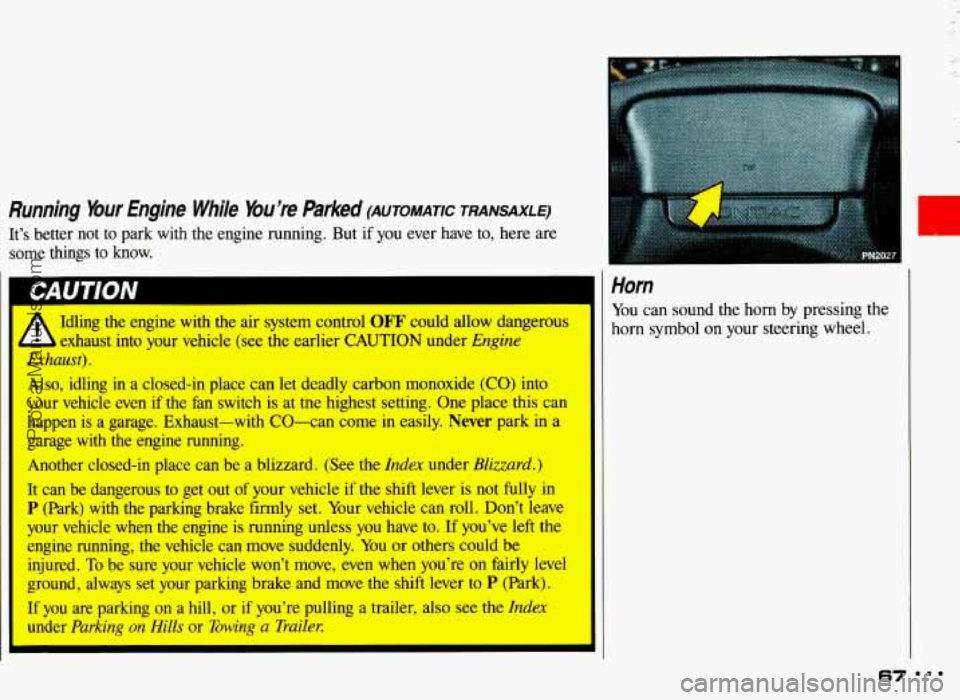
Running Your Engine While You’re Parked (AuToMmc TRANSAXLE)
It’s better not to park with the engine running. But if you ever have to, here are
some things to know.
A Idling the engine with the air system control OFF could allow dangerous
1 exhaust into your vehicle (see the earlier CAUTION under Engine
Exhaust).
Also, idling in a closed-in place can let deadly carbon monoxide (CO) into
your vehicle even if the
hn switch is at tne highest setting. One place this can
happen is a garage. Exhaust-with CO-can come
in easily. Never park in a
garage with the engine running.
Another closed-in place can be
a blizzard. (See the Index under Blizzard.)
It can be dangerous to get out of your vehicle if the shift lever is not fully in
P (Park) with the parking brake firmly set. Your vehicle can roll. Don’t leave
your vehicle when the engine is running unless you have
to. If you’ve left the
engine ruhing, the vehicle can move suddenly. You or others could be
injured.
To be sure your vehicle won’t move, even when you’re on fairly level\
ground, always set your parking brake and move the shift lever to J’ (Park). .
If you are parking on a hill, or if you’re pulling a trailer, also see the Index
under Parking on Hills or Towing a Trailer.
I’
Horn
You can sound the horn by pressing the
horn symbol on your steering wheel.
67
ProCarManuals.com
Page 88 of 306
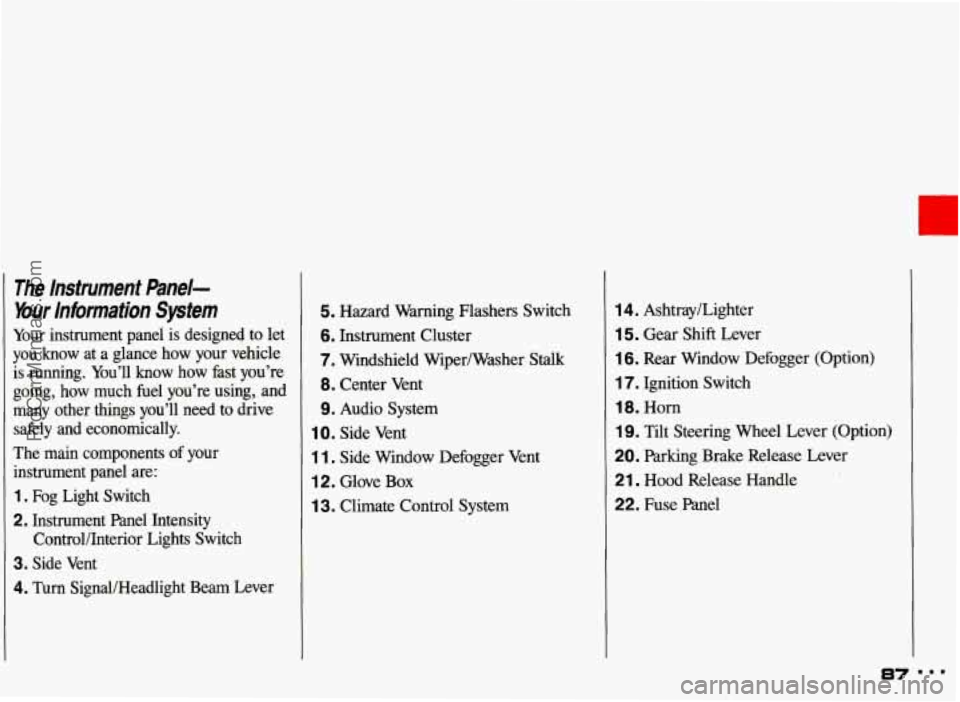
The lnstrument Panel-
bur Information System
Your instrument panel is designed to let
you know at a glance how your vehicle
is running. You’ll know how fast you’re going, how much fuel you’re using, and
many other things you’ll need to drive
safely and economically.
The main components
of your
instrument panel are:
1. Fog Light Switch
2. Instrument Panel Intensity
3. Side Vent
4. Turn SignaUHeadlight Beam Lever Control/Interior Lights Switch
5. Hazard Warning Flashers Switch
6. Instrument
Cluster
7. Windshield Wiper/Washer Stalk
8. Center Vent
9. Audio System
1 0. Side Vent
1 1. Side Window Defogger Vent
12. Glove Box
1 3. Climate Control System
14. Ashtray/Lighter
15. Gear Shift Lever
16. Rear Window Defogger (Option)
17. Ignition Switch
18. Horn
1 9. Tilt Steering Wheel Lever (Option)
20. Parking Brake Release Lever
21. Hood Release Handle
22. Fuse Panel
I
ProCarManuals.com
Page 140 of 306
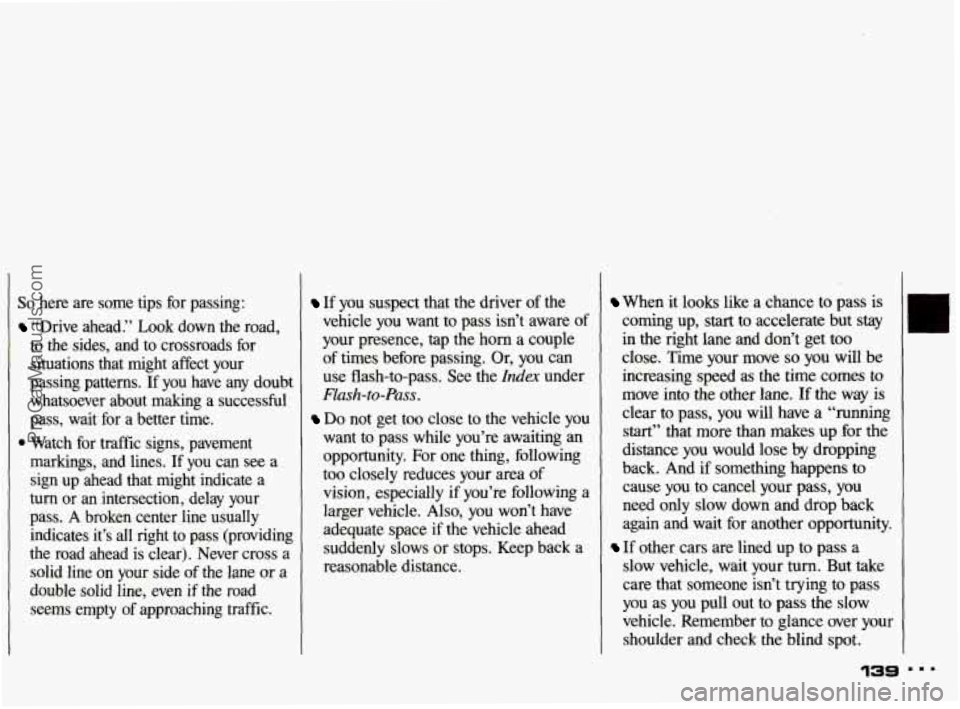
So here are some tips for passing:
“Drive ahead.” Look down the road,
to the sides, and to crossroads for situations that might affect your
passing patterns. If you have any doubt
whatsoever about making a successful
pass, wait for a better time.
markings, and lines.
If you can see a
sign up ahead that might indicate a
turn or an intersection, delay your
pass.
A broken center line usually
indicates it’s all right to pass (providing
the road ahead is clear). Never cross
a
solid line on your side of the lane or a
double solid line, even if the road
seems empty of approaching traffic.
0 Watch for traffic signs, pavement
If you suspect that the driver of the
vehicle you want to pass isn’t aware of
your presence, tap the horn a couple
of times before passing. Or, you can
use flash-to-pass. See the
Index under
Flash-to-Pass.
Do not get too close to the vehicle you
want to pass while you’re awaiting
an
opportunity. For one thing, following
too closely reduces. your area of
vision, especially if you’re following a
larger vehicle.
Also, you won’t have
adequate space if the vehicle ahead
suddenly slows or stops. Keep back a
reasonable distance.
When it looks like a chance to pass is
coming up,
start to accelerate but stay
in the right lane and don’t get too
close. Time your move
so you will be
increasing speed
as the time comes to
move into the other lane.
If the way is
clear to pass, you will have
a “running
start” that more than makes up for the
distance you would lose by dropping
back. And if something happens
to
cause you to cancel your pass, you
need only slow down and drop back
again and wait for another opportunity.
slow vehicle, wait your
turn. But take
care that someone isn’t trying to pass
you as you pull out
to pass the slow
vehicle. Remember to glance over your
shoulder and check the blind spot.
If other cars are lined up to pass a
ProCarManuals.com
Page 148 of 306

Tips on Driving in Fbg
If you get caught in fog, turn your
headlights on low beam, even in
daytime, You’ll see-and be seen-
better. Use your fog lights.
Don’t use your high beams. The light
will bounce
off the water droplets that
make up fog and reflect back at you.
Use your defogger.
In high humidity,
even a light build-up of moisture
on the
inside of the glass will cut down
on your
already limited visibility.
Run your
windshield wipers and washer occasionally. Moisture can build up on
the outside glass, and what seems to be fog may actually be moisture on the
outside of your windshield.
Treat dense fog as
an emergency. Try to
find a place to pull off the road. Of course
you want to respect another’s
property, but you might need to put something between you and moving
vehicles-space, trees, telephone poles,
a private driveway, anything that
removes you from other traffic.
If visibility is near zero and you must
stop but are unsure whether you are
away from the road,
turn your lights on,
start your hazard warning flashers, and
sound your horn at intervals or when
you hear approaching traffic.
Pass other vehicles in fog only if you
can see far enough ahead to pass safely.
Even then, be prepared to delay your
pass if you suspect the fog is worse
up
ahead. If other vehicles try to pass you,
make it easy for them.
City Driving
One of the biggest problems with city
streets is the amount of traffic on them.
You’ll want to watch out for what the
other drivers are doing and pay attention
to traffic signals.
Here are ways to increase your safety in
city driving:
Know the best way to get to where you
are going. Try not to drive around
trying to pick out a familiar street or
landmark. Get a city map and plan
your trip into
an unknown part of the
city just as you would for
a cross-
country trip.
Try to use the freeways that rim and
crisscross most large cities. You’ll save
time and energy. (See the next section,
Freeway Driving.
147
... . -
ProCarManuals.com
Page 250 of 306
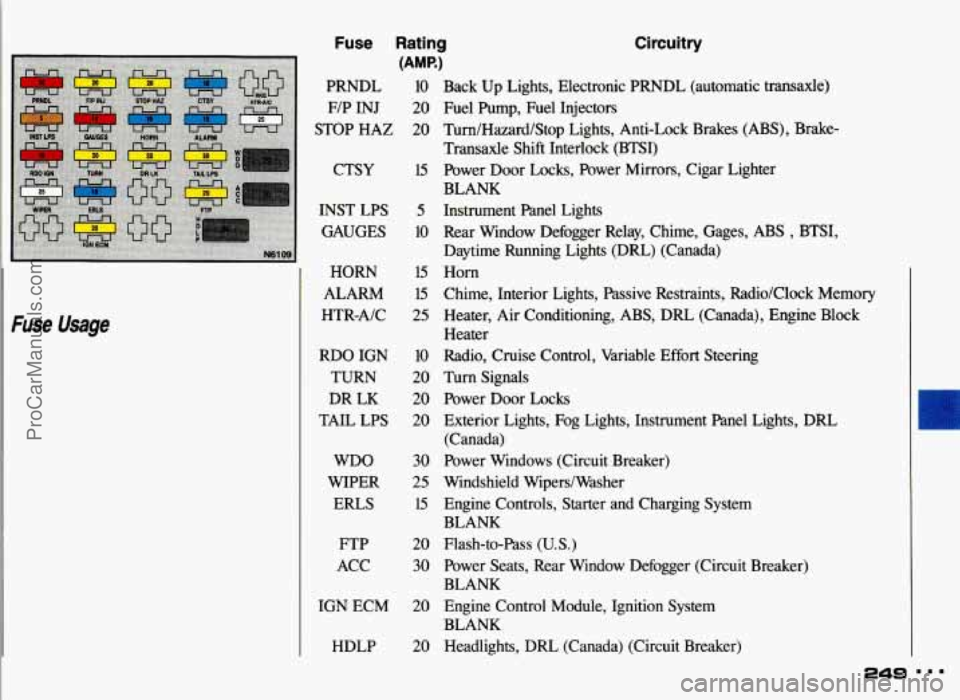
Fuse Rating Circuitry
Fuse Usage
HORN
ALARM
HTR-A/C
RDO IGN
TURN
DR LK
TAIL LPS
WDO
WIPER ERLS
FTP
ACC
IGN ECM
HDLP
15
15
25
10
20
20
20
30
25
15
20
30
20
20
Back Up Lights, Electronic PRNDL (automatic transaxle)
Fuel Pump, Fuel Injectors
Turn/Hazard/Stop Lights, Anti-Lock Brakes
(ABS), Brake-
Transaxle Shift Interlock
(BTSI)
Power Door Locks, Power Mirrors, Cigar Lighter
BLANK
Instrument Panel Lights
Rear Window Defogger Relay, Chime, Gages,
ABS , BTSI,
Daytime
Running Lights (Dm) (Canada)
Horn
Chime, Interior Lights, Passive Restraints, Radio/Clock Memory
Heater, Air Conditioning, ABS, DRL (Canada), Engine Block
Heater
Radio, Cruise Control, Variable
Effort Steering
Turn Signals
Power Door Locks
Exterior Lights, Fog Lights, Instrument Panel Lights, DRL
(Canada)
Power Windows (Circuit Breaker)
Windshield WipedWasher
Engine Controls, Starter and Charging System
BLANK
Flash-to-Pass
(US.)
Power Seats, Rear Window Defogger (Circuit Breaker)
BLANK
Engine Control Module, Ignition System
BLANK
Headlights, DRL (Canada) (Circuit Breaker)
ProCarManuals.com
Page 298 of 306
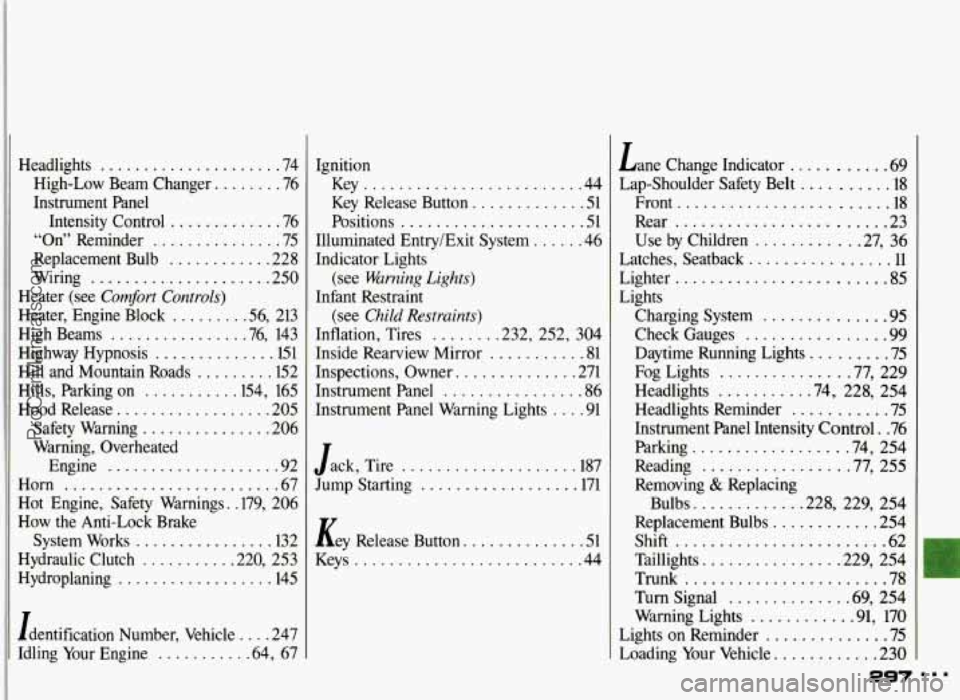
Headlights ..................... 74
High-Low Beam Changer
....... -76
Instrument Panel
Intensity Control
............. 76
“On” Reminder
............... 75
Replacement Bulb
............ 228
Wiring
..................... 250
Heater (see
Comfort Controls)
Heater, Engine Block ........ .56. 213
High Beams
............... .76. 143
Highway Hypnosis
.............. 151
Hill and Mountain Roads
......... 152
Hood Release
.................. 205
Safety Warning
............... 206
Warning, Overheated
Engine
.................... 92
Horn
......................... 67
Hot Engine. Safety Warnings . .179. 206
How the Anti-Lock Brake
System Works
................ 132
Hydraulic Clutch
.......... .220. 253
Hydroplaning
.................. 145
Hills. Parking on
.......... .154. 165
Identification Number. Vehicle
.... 247
Idling Your Engine
.......... .64. 67
Ignition
Key
......................... 44
Key Release Button
............. 51
Positions
..................... 51
Illuminated Entry/Exit System
...... 46
Indicator Lights
Infant Restraint
Inflation. Tires
....... .232. 252. 304
Inside Rearview Mirror
........... 81
Inspections. Owner
.............. 271
Instrument Panel
................ 86
Instrument Panel Warning Lights .... 91
(see Warning Lights)
(see Child Restraints)
.................... J ack. Tire 187
Jump Starting
.................. 171
Key Release Button
.............. 51
Keys
.......................... 44 Lane
Change Indicator
........... 69
Lap-Shoulder Safety Belt .......... 18
Front
........................ 18
Rear ........................ 23
Use by Children
........... .27, 36
Latches. Seatback ................ 11
Lighter ........................ 85
Lights
Charging System
.............. 95
Check Gauges ................ 99
Daytime Running Lights ......... 75
Fog Lights .............. .77. 229
Headlights
.......... .74. 228. 254
Headlights Reminder
........... 75
Instrument Panel Intensity Control
. . 76
Parking ................. .74. 254
Reading
................ .77. 255
Removing
& Replacing
Bulbs
............ .228. 229. 254
Replacement Bulbs
............ 254
Shift
........................ 62
Taillights
............... .229. 254
Trunk ....................... 78
Turn Signal ............. .69. 254
Warning Lights
........... .91. 170
Lights on Reminder .............. 75
Loading Your Vehicle ............ 230
297 ’ ’
ProCarManuals.com